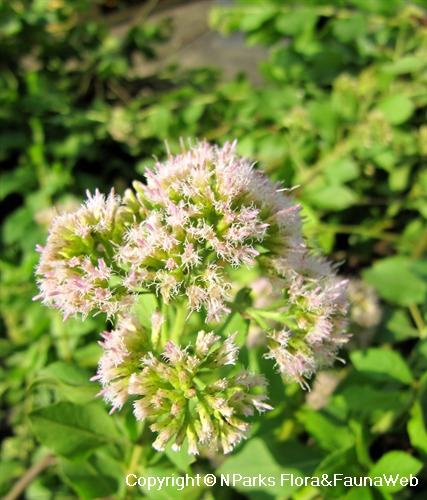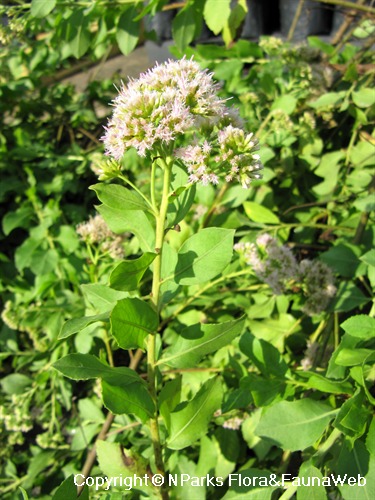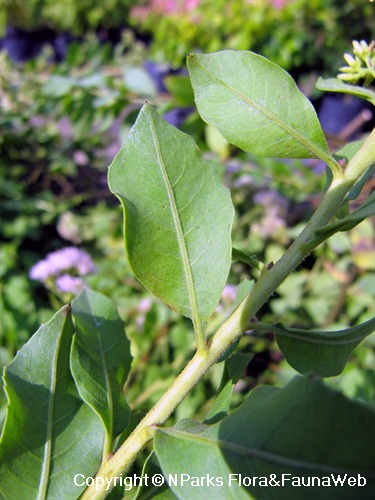
Back
Pluchea indica (L.) Less.
| Family Name: | Asteraceae (Compositae) |
| Common Name: | Indian Camphorweed, Indian Fleabane, Indian Pluchea, 阔苞菊 |
Name
Classifications and Characteristics
| Plant Division | Angiosperms (Flowering Seed Plants) (Dicotyledon) |
|---|---|
| Plant Growth Form | Shrub |
| Lifespan (in Singapore) | Perennial |
| Mode of Nutrition | Autotrophic |
| Plant Shape | Shrubby |
| Maximum Height | 3 m |
Biogeography
| Native Distribution | Singapore, India to Japan and Malesia and south to Australia |
|---|---|
| Native Habitat | |
| Preferred Climate Zone | Tropical, Sub-Tropical / Monsoonal |
| Local Conservation Status | Native to Singapore (Least Concern (LC)) |
Description and Ethnobotany
| Growth Form | It is a shrub with many branches up to 2 m tall. |
|---|---|
| Foliage | Leaves are elliptic or obovate and slightly hairy or nearly hairless (2 - 6 x 1 - 3 cm) with a toothed leaf margin. They either lack a leaf stalk (sessile) or have a short one. Leaf texture is dry and papery. An aroma is produced when the leaf blades are crushed. |
| Flowers | Its tubular flowers develop in pink or purplish-pink heads that are 7 mm wide. Its flower heads are found together in clusters or on branched shoots, at the leaf axils or the end of leafy twigs. Its flowers have a cup-like structure of white hairs that are spreading and 3–4 mm long. |
| Fruit | Its indehiscent fruit (fruit that does not open to release its content when it is ripe) is brown, dry, one-seeded, cylindrical, five-ribbed, and 1 mm long. |
| Habitat | It grows along the seashore, tidal swamps and open areas in mangroves. It occurs locally along Upper Boon Keng Road, in Kranji area, Pulau Ubin, and Pulau Tekong. |
| Associated Fauna | Its flowers are pollinated by butterflies as well as other insects. |
| Cultivation | It can be propagated by seed as well as stem cutting. |
| Etymology | The genus Pluchea commemorates N.A. Pluche, a French naturalist (1688–1761). The specific epithet indica is Latin for being related to India, a reference to part of the species' natural distribution. |
| Ethnobotanical Uses | Edible Plant Parts : Edible Leaves, Edible Stems Food (Fruit or Vegetable): In Malaysia, fresh leaves are consumed in a traditional salad called ulam. Medicinal: Scientific Evidence of Medicinal Properties
|
Landscaping Features
| Landscaping | It is suitable for streetscapes, parks and gardens for its silvery-looking leaves. |
|---|---|
| Desirable Plant Features | Ornamental Flowers, Ornamental Foliage |
| Landscape Uses | Suitable for Roadsides, Parks & Gardens, Coastal, Beachfront / Shoreline, Hedge / Screening, Riverine |
| Thematic Landscaping | Silver Garden, Water Garden, Bird & Wildlife Garden |
Fauna, Pollination and Dispersal
| Fauna Pollination Dispersal Associated Fauna | Butterfly-Attracting (Flower Nectar) |
|---|---|
| Pollination Method(s) | Biotic (Fauna) |
| Seed or Spore Dispersal | Abiotic (Water) |
Plant Care and Propagation
| Light Preference | Full Sun |
|---|---|
| Water Preference | Lots of Water, Moderate Water, Little Water |
| Rootzone Tolerance | Drought Tolerant, Moist Soils, Waterlogged Soils (Drains Site), Well-Drained Soils, Saline Soils / Salt Spray, Fertile Loamy Soils |
| Propagation Method | Seed, Stem Cutting (Herbaceous) |
Foliar
| Foliage Retention | Evergreen |
|---|---|
| Mature Foliage Colour(s) | Green - Light Green, Silver / Grey |
| Mature Foliage Texture(s) | Thick |
| Foliar Type | Simple / Unifoliate |
| Foliar Arrangement Along Stem | Alternate, Spiral |
| Foliar Attachment to Stem | Sessile |
| Foliar Shape(s) | Non-Palm Foliage (Elliptical, Obovate) |
| Foliar Venation | Pinnate / Net |
| Foliar Margin | Dentate |
| Foliar Apex - Tip | Acute |
| Foliar Base | Attenuate |
| Typical Foliar Area | Microphyll ( 2.25cm2 - 20.25 cm2 ) |
| Typical Foliar Size Remarks | leaf blade 2 - 6 x 1 - 3 cm |
| Typical Foliar Size | 2 cm to 6 cm |
Floral (Angiosperm)
| Flower & Plant Sexuality | Bisexual Flowers |
| Flower Colour(s) | Pink, Purple |
|---|---|
| Flower Texture(s) | Hairy / Hirsute |
| Flower Grouping | Cluster / Inflorescence |
| Flower Location | Axillary, Terminal |
| Inflorescence Type | Compound Corymb |
| Flowering Period | Free-Flowering |
| Flowering Habit | Polycarpic |
| Flower Colour(s) Remarks | pale lilac or pink |
Fruit, Seed and Spore
| Mature Fruit Colour(s) | Brown |
|---|---|
| Mature Fruit Texture(s) | Wrinkled |
| Fruit Classification | Simple Fruit |
| Fruit Type | |
| Seed Quantity Per Fruit | Few (1-5) |
References
| References | <1> Singdam, P., Naowaboot, J., Senggunprai, L., Boonloh, K. & Pannangpetch, P. (2022). Pluchea indica leaf extract alleviates dyslipidemia and hepatic steatosis by modifying the expression of lipid metabolism-related genes in rats fed a high fat-high fructose diet. Prev. Nutr. Food Sci. 27(4): 384-398. <2> Chan, E.W.C., Ng, Y.K., Wong, S.K., Chan, H.T. (2022). Pluchea indica: An updated review of its botany, uses, bioactive compounds and pharmacological properties. Pharm. Sci. Asia 49(1): 77-85. <3> Kiew, R., Chung, R.C.K., Saw, L.G., Soepadmo, E., eds. (2021). Flora of Peninsular Malaysia, Malayan Forest Records no. 49, ser. 2, Seed Plants, vol. 8. Malaysia: Forest Research Institute Malaysia, Ministry of Energy and Natural Resources. |
|---|
Image Repository
Others
| Master ID | 30749 |
|---|---|
| Species ID | 5078 |
| Flora Disclaimer | The information in this website has been compiled from reliable sources, such as reference works on medicinal plants. It is not a substitute for medical advice or treatment and NParks does not purport to provide any medical advice. Readers should always consult his/her physician before using or consuming a plant for medicinal purposes. |


